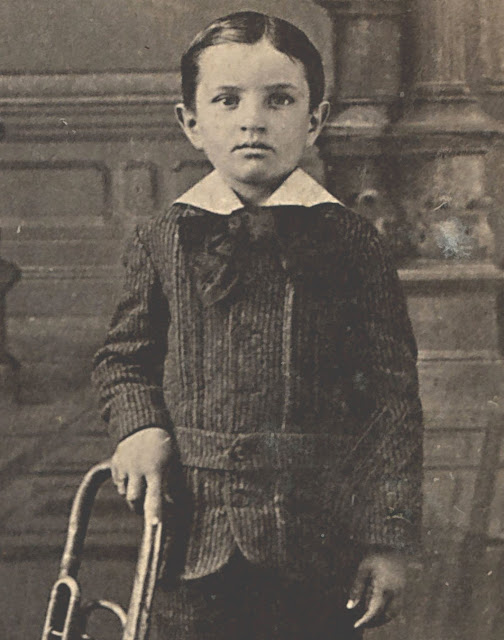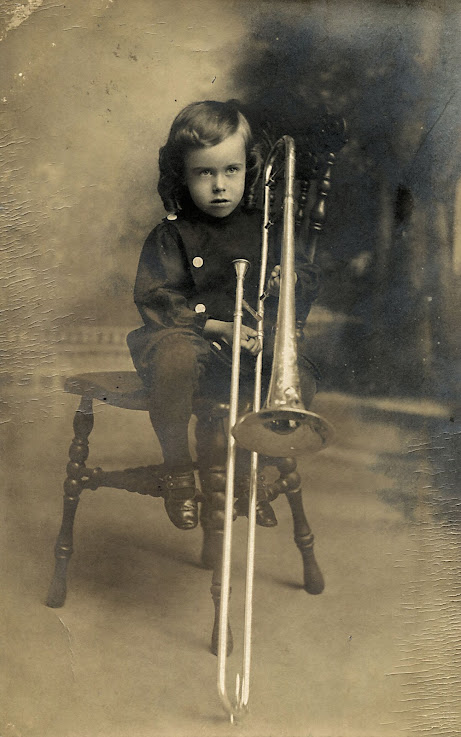A skilled portrait photographer
always tries to satisfy a customer.
Yet when taking photographs of children
a photographer recognizes that
their clientele is not the child but its parents.
The photographer provides only the camera.
A child's wardrobe, hair, and accessories
are mother's responsibility.
always tries to satisfy a customer.
Yet when taking photographs of children
a photographer recognizes that
their clientele is not the child but its parents.
The photographer provides only the camera.
A child's wardrobe, hair, and accessories
are mother's responsibility.
In the brief time that a photographer
has charge of an unfamiliar child,
they must quickly arrange the subject,
position the lights, focus the camera,
and wait for that perfect moment
to release the shutter.
has charge of an unfamiliar child,
they must quickly arrange the subject,
position the lights, focus the camera,
and wait for that perfect moment
to release the shutter.
Even the best cameramen know they can command
the attention of a young boy or girl for just an instant.
Any delay brings unwanted movement,
a fuzzy eye blink or blurring shudder.
Likewise undue haste might miss
a candid gaze or youthful smile.
the attention of a young boy or girl for just an instant.
Any delay brings unwanted movement,
a fuzzy eye blink or blurring shudder.
Likewise undue haste might miss
a candid gaze or youthful smile.
If the photographer's timing is good
they capture a perfect picture for the parents.
An image of childhood yet one full of blooming personality
and brimming with a parent's hope for the future.
they capture a perfect picture for the parents.
An image of childhood yet one full of blooming personality
and brimming with a parent's hope for the future.
Today I present
four beautiful studio photos
of handsome young boys holding musical instruments
that I'm fairly certain
none of them could actually play.
four beautiful studio photos
of handsome young boys holding musical instruments
that I'm fairly certain
none of them could actually play.
The first little boy sits on a hard wooden chair that is too tall for his feet
to reach the floor. His long hair has been neatly curled and oiled as he gazes
at someone to the side of the camera. Mother maybe? He clutches a slide
trombone in a tight two-handed grip. The instrument gleams in the studio light
showing off its elaborate engraving on the bell. He looks like a child who has
been told several times, "Be very careful of Daddy's trombone. Don't drop
it!"
A trombone's slide has seven positions that lengthen the instrument and give
it a full complement of musical notes. It requires a fairly long arm stretch
which would clearly be beyond the reach of this boy. My guess is that dad (or maybe
mum) aspired that their son might soon take up the instrument. But looking
at this kid, I have a hunch he chose something different. Unfortunately his
postcard is unmarked so all I know is that it was taken somewhere in
America around 1900-1910.
* * *
The next boy is about the same age, around four or five maybe. He is dressed
in a dark sailor suit with short knee pants. He stands on a fur rug in front
of a large wooden bench and holds a shiny cornet. Once again the lighting
picks up the fancy engraving on the bell. His short hair is cut in a military
style and pinned to his blouse is a small medal. It resembles the crossed guns
insignia worn by a U.S. Navy Gunner's Mate, though it might be the crossed
cannon of the U.S. Army artillery or crossed rifles of the infantry.
The way the boy holds the cornet is a not the usual way a real cornet player would hold the instrument. But more critical is that his fingers are too small to mash the valve buttons. So I think this was a picture taken for dad, maybe a sailor serving
aboard a navy ship, who also played the cornet.
This postcard does have a note on the back but sadly the clues are incomplete.
There is a date, April 15: a name, Chas. Erb.; a place,
Green Wick, K-town, and a mystery number, –16.
Without a year we have only the little corner triangles in the AZO stamp logo to
go by. When two point up and two point down it is roughly a photo paper style
that the AZO company produced from 1918 to 1930.
The forename Chas. is Charles, but is Erb. a full surname or an abbreviation? It is an uncommon name in Ancestry.com.
The forename Chas. is Charles, but is Erb. a full surname or an abbreviation? It is an uncommon name in Ancestry.com.
And the place name doesn't match anything in Google Maps. There is no Green Wick, though plenty of Greenwichs. Initially I though K-Town was a short name for Kansas City, but Wikipedia has an entry for K-Town which does not include it. Of the cities in the United States with that nickname are Kaysville, Utah; Knoxville, Tennessee; Kenosha, Wisconsin; and Kearny, New Jersey. My guess is that it signifies Kearny, NJ which is on the Hudson River east of New York City, and near a major naval shipyard.
_ _ _
* * *
The next postcard photo is of an older boy, somewhere between 8 and 12 years old. He is dressed in a proper bandsman's uniform and is holding a bassoon that is an inch or two taller. A bassoon is an unusual instrument to find in a small town band. Typically it was played only in large military bands. It's a bass instrument with complicated keys that require a wide finger stretch. This boy's hands are again too small to properly cover the finger holes and keys.
His cap, and braided cord accoutrements are of a military style but a closer look shows his tunic sleeves are folded under and his trousers cuffs are tucked into his socks. This was clearly a borrowed uniform and bassoon to stage a photo for Dad or Grandpa. The photo's location may not even be a photographer's studio but instead it was taken behind a concert stage or even in a residential home.
There are no marks on this postcard, but the letters, MINN are on the tunic's collar. Minnesota? I date the photo to around 1905-1915. He seems a sharp lad that any dad would be proud to see playing in a band.
* * *
The last boy is the oldest in time, though he is only about age 5 or 6. His picture is on a small CdV photo, a carte de viste, taken in the 1870s or 80s. He stands with a tenorhorn in a photographer's studio in front of a crudely painted backdrop. His hair is neatly combed and he wears a sturdy corduroy jacket with knee pants. It's not impossible that he played this instrument, a member of the saxhorn/euphonium brass family. I have several photographs of family bands which had young siblings who played a tenorhorn. However he just doesn't have the air of a real brass player so I'm uncertain.
However his small size certainly fits with my group of diminutive pseudo-musicians. The photo has a backstamp of the photographer, Adolph Rapp of Glasgow, Kentucky. This town is about halfway between Nashville, Tennessee and Louisville, Kentucky. In 1870 Glasgow, KY had a population of 733 residents. It jumped 106.0% to 1,510 in 1880 and then to 2,051 in 1890, so this photo likely comes from Glasgow's boom years.
I can't finish this post about young non-musicians
without showing off what talented kids are capable of
when they get the right musical training.
without showing off what talented kids are capable of
when they get the right musical training.
Here is an astonishingly great concert from Japan
by the Hirasanishi Elementary School Brass Band
performing the Benny Goodman classic, "Sing Sing Sing".
by the Hirasanishi Elementary School Brass Band
performing the Benny Goodman classic, "Sing Sing Sing".
Look out for something that is not there
and you will be even more amazed.
and you will be even more amazed.
Did you spot any music stands?
This is my contribution to Sepia Saturday
where cuteness in any size is always awesome.
where cuteness in any size is always awesome.












3 comments:
My favorites of the 4 photographs are the two middle ones. Love the expressions on those boys' faces - especially the second in line of the four. So engaging. :) The video is wonderful. For kids that young to be able to feel the swing in a piece like that so well is amazing! Their bouncing director helped with that, no doubt. But swing still needs to be felt. And obviously, it was memorized. Whoa!
That first little boy looks like he will rebel and cut those curls off soon as he can.
I kept looking and looking at the band for what wasn't there and I didn't catch it at all until I saw your question about the stands. The way they had to move up and down and hold the instruments up, they might not have been able to use them anyway. Amazing.
Excellent post! The detail on the photos is amazing. I also looked closely at the insignia on the Navy uniform. On Charles Erb., you may want to try Ancestry's wild card characters and search for Charles Erb* to see what turns up -- a long shot, but worth exploring. And that clip at the end is amazing -- no music stands, just like Count Basie's band, and the tune got me up and dancing!
Post a Comment